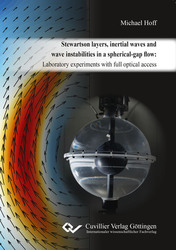| Departments | |
|---|---|
| Book Series (96) |
1378
|
| Nachhaltigkeit |
3
|
| Gesundheitswesen |
1
|
| Humanities |
2363
|
| Natural Sciences |
5406
|
| Mathematics | 229 |
| Informatics | 319 |
| Physics | 980 |
| Chemistry | 1363 |
| Geosciences | 131 |
| Human medicine | 243 |
| Stomatology | 10 |
| Veterinary medicine | 108 |
| Pharmacy | 147 |
| Biology | 835 |
| Biochemistry, molecular biology, gene technology | 121 |
| Biophysics | 25 |
| Domestic and nutritional science | 45 |
| Agricultural science | 1004 |
| Forest science | 201 |
| Horticultural science | 20 |
| Environmental research, ecology and landscape conservation | 148 |
| Engineering |
1791
|
| Common |
98
|
|
Leitlinien Unfallchirurgie
5. Auflage bestellen |
|
Advanced Search
Stewartson layers, inertial waves and wave instabilities in a spherical-gap flow (English shop)
Laboratory experiments with full optical access
Michael Hoff (Author)Preview
Table of Contents, PDF (58 KB)
Extract, PDF (160 KB)
Many planetary bodies in our solar system consist of a solid inner and a liquid outer core, surrounded by a solid mantle. Planetary cores do not rotate constantly but undergo certain variations in the angular speed due to gravitational couplings. Such rotational background systems have a significant influence on the fluid in the interior of planets and stars. It is worth to know the interaction between the core rotation and the interior of the fluid to understand tidal heating, fluid mixing, or the generation of magnetic fields. An opportunity to explore aspects of the dynamics in planetary cores is to do laboratory experiments. The present work focuses on experiments in a rapidly rotating fluid between two spherical shells. A common feature arising in such systems is the occurrence of inertial waves, which are Coriolis-restored propagating internal oscillations. In a system where the inner sphere oscillates around a mean angular speed, inertial waves appear as plane waves. Their excitation efficiency and reflection behavior at inclined walls as well as their tendency to form wave attractors is investigated. In a system where the spheres rotate differentially, so-called global inertial modes arise. Besides the investigation of mode excitation, structure and interaction, the present study reveals a new secondary instability of inertial modes characterized by a clear transition to small-scale turbulence. Finally, the formation of the Stewartson layer is investigated for both forcing systems. Especially the shear instability of the Stewartson layer leads to wave motions, so-called Rossby waves, whose very particular properties in the spherical gap are studied. It is found that these Rossby waves play a crucial role for mode selection in a rapidly rotating fluid between spherical shells.
| ISBN-13 (Hard Copy) | 9783736996441 |
| ISBN-13 (eBook) | 9783736986442 |
| Language | English |
| Page Number | 238 |
| Edition | 1. |
| Publication Place | Göttingen |
| Place of Dissertation | Cottbus |
| Publication Date | 2017-10-08 |
| General Categorization | Dissertation |
| Departments |
Physics
Astrophysics and astronomy Geosciences Physics of the terrestrial body Technical mechanics |
| Keywords | Stewartson, layers, spherical-gap |








